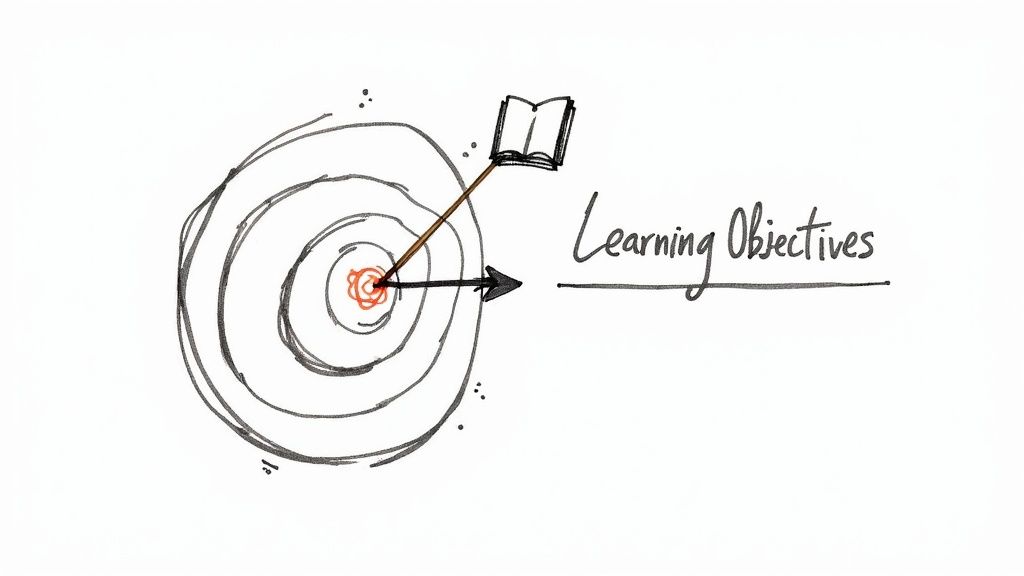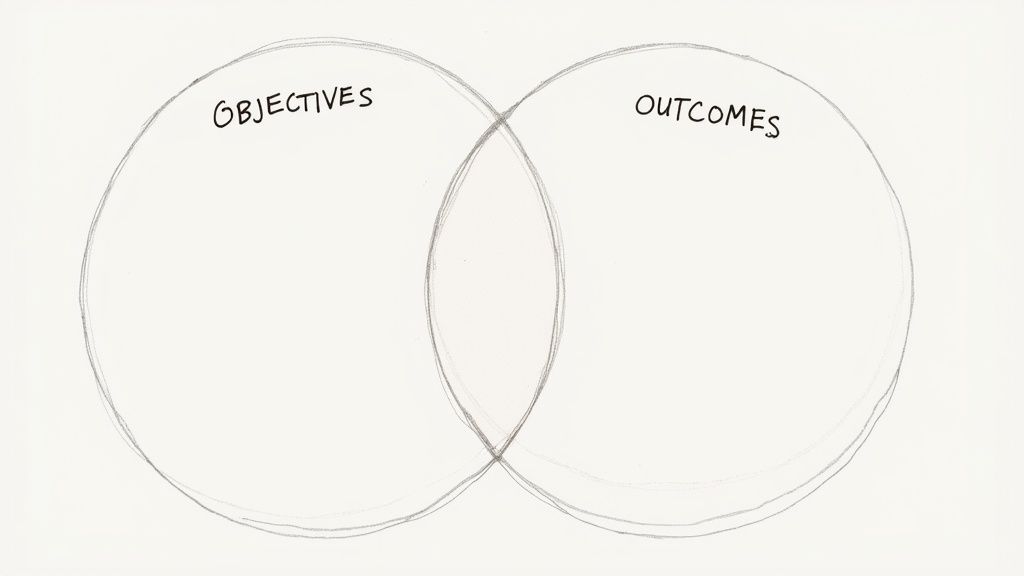When we talk about learning objectives vs. learning outcomes, the simplest way to think about it is this: objectives are the instructor's game plan, while outcomes are what the student can actually do after the lesson. Objectives are the roadmap for the course, laying out the topics and activities. Outcomes, on the other hand, are the destination—the specific, measurable skills a learner walks away with.
In the world of instructional design, getting the distinction between learning objectives and learning outcomes right is fundamental to building training that actually works. People often use these terms interchangeably, but they represent two completely different sides of the same coin. One is about the teaching, and the other is about the results.
Think of it this way: learning objectives are all about the instructor. They are statements that describe what the course will cover—the "what" and "how" of the lesson plan. A classic objective might sound like, "This module will introduce the AI features in our new software." It’s a statement of intent.
Learning outcomes, however, flip the script to focus on the student. They are specific, measurable statements about what learners will be able to do once the training is over. This is where the rubber meets the road—the provable skills that show learning actually happened. For a deeper dive into how these roles impact course design, Dartmouth offers some great insights.
This chart does a great job of laying out the fundamental differences in focus and timing.

As you can see, objectives are all about the pre-planning phase from the teacher's point of view. In contrast, outcomes define the post-learning achievement from the learner's perspective. It might seem like a small shift, but it changes everything, from how you build a module in a Learning Management System (LMS) to how you design a piece of microlearning content.
For a quick reference, this table breaks down the key distinctions between the two.
Ultimately, starting with the end in mind (the outcomes) is what helps you build a much more effective and targeted learning experience.

Think of learning objectives as the architectural blueprints for any course you're building. They lay out your commitment as the instructor—the 'what' and 'how' of the entire teaching journey. This is the foundational plan that guides every single decision you make, from content to delivery.
This instructor-centric focus is the key difference when comparing learning objectives vs. learning outcomes. An objective spells out the scope of your content, the tools you plan to use, and the activities you’ll run. It’s essentially your promise to the learner about what the training session will actually cover.
When you write good objectives, they act as a filter for your content. You’ll know exactly what to include and, maybe more importantly, what you can confidently leave out. This all happens in the planning stage, ideally right after you've figured out what your audience needs. If you want to dig into that initial step, our guide on how to conduct a training needs analysis is a great place to start.
Clear objectives even help you choose the right tools and format for the job. For instance:
Objective: Introduce learners to our new AI-powered sales dashboard.
Objective: Demonstrate how to use advanced filtering features in the software.
This whole idea of using precise, observable language in objectives isn't new. It has its roots in behaviorist educational theories from the mid-20th century. A psychologist named Robert Mager was a huge advocate for this, pushing for clarity to remove any guesswork for students.
A strong learning objective is more than a simple statement. It's a strategic tool that aligns your teaching methods with your goals, making sure every piece of your course serves a real purpose.
By starting with solid objectives, you’re building a logical and effective learning experience from the ground up. You're setting the stage for what your learners will eventually be able to do.

If learning objectives are the roadmap, then learning outcomes are the destination. This is the moment where the spotlight shifts completely to the learner. What can they actually do now that the training is over? Outcomes are the tangible, measurable achievements that prove real learning took place.
This shift in focus—from the instructor's intention to the learner's demonstrated skill—is the core difference in the whole learning objectives vs learning outcomes conversation. A well-written outcome doesn't settle for fuzzy words like "understand." Instead, it uses strong, action-based verbs to define the specific skills and knowledge a learner walks away with.
To write a solid outcome, you have to think in terms of observable actions. What can you see, measure, or test? Verbs like ‘analyze,’ ‘create,’ ‘evaluate,’ and ‘troubleshoot’ become your go-to tools. We dive deeper into how to structure these in our guide on what is Bloom's Taxonomy.
A powerful outcome gives your learners a clear target to hit. Just look at the difference here:
See? The second one is specific and measurable. It tells you exactly what kind of assessment or project you need to create to prove the learning happened.
Learning outcomes flip the script on training. It's no longer about passively absorbing information; it becomes an active mission to gain real-world skills. This empowers learners to take ownership and see exactly how their effort pays off.
This kind of clarity is a massive win for engagement, especially when you're delivering training through a modern LMS or LXP (Learning Experience Platform). The numbers back this up, too. A recent survey found that 87% of instructors believe that clearly stated learning outcomes directly boost student engagement. Ultimately, strong outcomes are how you prove a course delivers real-world value.

Think of learning objectives and outcomes as two sides of the same coin. They aren't competing ideas; they're partners that make instructional design work. Together, they give every video, activity, and quiz a clear reason for being there. The objective is the instructor's game plan, and the outcome is the proof that the learner got it.
The whole learning objectives vs learning outcomes debate is really about cause and effect. The instructor’s intent (the objective) lays the groundwork for the learner's new skill (the outcome). When these two are in sync, you get a straight line from teaching to doing.
Let's say a company is rolling out new software and needs to get its team up to speed on data analysis. An instructional designer’s first move is to connect the goal of the training with what a learner will achieve.
Here’s what that looks like in a few common corporate training situations:
Scenario 1: AI Analytics Rollout
Scenario 2: Compliance Microlearning
This tight alignment makes the whole learning process feel purposeful. The objective shapes the training content—maybe some short videos or a hands-on guide built in Articulate Storyline—while the outcome dictates what the final test will look like.
When objectives and outcomes are tightly linked, learners can see a clear line from what they are being taught to what they will be able to do. This connection is a huge driver of motivation and engagement.
Now let's scale this up for a bigger program, like a leadership course for new managers hosted on a Learning Experience Platform (LXP). The main goal is to improve their coaching skills.
The instructional designer would map out the journey like this:
The LXP becomes the hub for meeting the objective, hosting videos, articles, and peer discussions. But the real test is the outcome—a role-playing assessment that proves the manager can apply what they learned in a practical, real-world way.
Knowing the difference between learning objectives and learning outcomes is one thing, but actually writing good ones is where the rubber meets the road. I see it all the time—vague verbs like "understand" or "know" creep into training plans. These are the enemies of great instructional design because you can't measure them.
How do you prove someone "understands" a topic? You can't. But you can measure if they can apply it, analyze it, or create something with it.
That’s why frameworks like SMART (Specific, Measurable, Achievable, Relevant, Time-bound) are so useful. Even if the "Time-bound" part applies to the whole course, the first four letters are pure gold for writing statements that get results. The secret is to anchor your objectives and outcomes with strong action verbs that point to something you can actually see or measure.
Let's take a look at how to transform some weak, fuzzy statements into sharp objectives and powerful outcomes. This table gives you a simple "before and after" to help you see the shift from abstract ideas to concrete actions. And if you want to go even deeper, we have a complete guide on how to write learning outcomes.
See the difference? The improved statements move from a general idea to a specific, observable task. The objective clearly lays out the instructor’s plan, defining what's on the agenda. The outcome, on the other hand, describes exactly what the learner will be able to do when they're done.
Think of a good learning outcome as a clear promise to your learner. It tells them precisely what they'll walk away with, which kills any confusion and gives them a clear goal to aim for. That kind of clarity is a huge motivator.
Whether you've been designing courses for years or are just getting started, this "before and after" mindset is a great way to gut-check your work. It forces you to focus on the tangible skills your training delivers, making sure every lesson is built to make a real impact.
Even after breaking down the difference between the instructor's plan (objectives) and the learner's results (outcomes), a few questions tend to bubble up. Let's clear up some of the common sticking points.
I see this one all the time, and it's a trap. It feels right, but you should steer clear of using the word 'understand'. Why? Because it’s impossible to measure.
How do you prove someone understands a concept? You can't see inside their head. Instead, you have to ask them to do something that proves their understanding. So, swap out vague words like "understand" for action verbs. Instead of "Learners will understand the new software," try something like, "Learners will demonstrate how to complete a core task in the new software."
In a word, yes. Think of it this way: objectives are your roadmap for building the course. They help you decide what to teach, what activities to include, and which tools—like the Articulate Suite—will get the job done.
Outcomes, on the other hand, are the destination for the learner. They're what you'll use to measure whether the whole thing was a success. One guides the creation; the other proves the result. You can't have one without the other if you want to create effective training.
The objective is your promise to the learner about what you will teach. The outcome is the learner's proof that they can apply it. Both are essential for creating training that delivers real value.
The exact same principles apply, just on a much tighter scale. Every single piece of microlearning, no matter how short, needs a razor-sharp objective and a matching outcome.
For example:
This focus is what makes microlearning so powerful. It ensures every tiny lesson in your Learning Management System (LMS) has a clear, measurable purpose and doesn't waste anyone's time.
Ready to build eLearning content that actually gets results? At Relevant Training, we live and breathe this stuff. We specialize in creating and updating training materials for businesses, making sure every single module is built on a solid foundation of clear objectives and measurable outcomes.